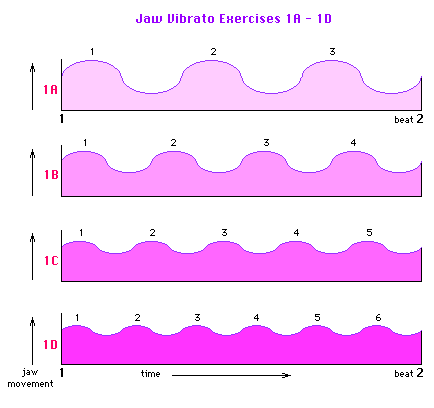Vibrato
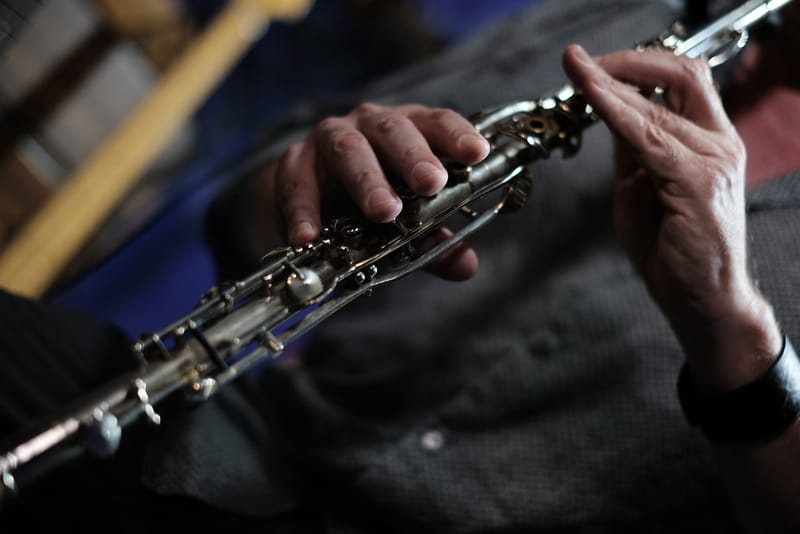
Vibrato can be described as a slight fluctuation in pitch or tone intensity to enrich the sound.
When playing vibrato in a group make sure that your frequency matches that of your section leader (or of the rest of the group).
SAX 10.2 - The Jaw Vibrato
The most commonly used vibrato method for the saxophone is the jaw vibrato.
In the jaw vibrato the lower jaw moves smoothly up and down on its hinges.
This causes fluctuations of :
- the size and shape of the upper oral tract (mouth), and
- the pressure of the embouchure.
Until the late 1970s it was thought that the vibrato was exclusively the result of fluctuating embouchure pressure.
In the 1980s the general opinion swung the other way towards the believe that the oral tract changes were fully responsible for the vibrato effect.
I personally believe that both fluctuations contribute to the jaw vibrato.
SAX 10.3 - Jaw Vibrato Exercises
The Jaw vibrato exercises aim to develop smooth flowing jaw movements.
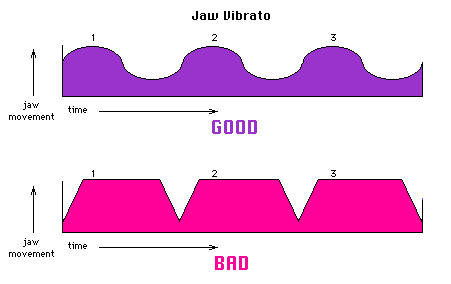
Exercise 1 - Set the metronome at 35 (beats per minute)
- A. - Practise three fluctuations per beat : "wawawa"
- This is a very low frequency.
Extend your jaw downwards as far as possible without losing the embouchure.
Do not worry about the sound you produce. Just try to maintain a fluent motion of the jaw.
Play each note of the G major scale (over 1 octave) this way, two beats for each note ("wawawawawawa"). Play the scale in ascending order. - B. - Practise four fluctuations per beat : "wawawawa"
- When you have reached the upper G of the G major scale in exercises 1A, descend in the same way, but now at a frequency of four waws per beat.
- C. - Practise five fluctuations per beat : "wawawawawa"
- Ascend the G major scale again, each note for two beats (8 waws).
If you have difficulty in playing 5 waws in a beat evenly, subdivide each 5 into a 3 and a 2. - D. - Practise six fluctuations per beat : "wawawawawawa"
- When you have reached the upper G of the G major scale in exercises 1C, descend in the same way, but now at a frequency of six waws per beat.
As you proceed through exercises 1A to 1D the amplitude (vertical jaw movement) decreases as the frequency (of waws) increases.
Regular practice of these exercises for 5 - 10 minutes per day will start to produce a good vibrato action after about 12 months.
SAX 10.4 - The Tongue Vibrato
A less common (recent) vibrato technique is the Tongue Vibrato.
In the experiment in Lesson 9 we have seen that fluctuations of the tongue can produce variations in tone timbre and pitch.
This forms the basis for the Tongue Vibrato.
 | The tongue vibrato consists of continuous tongue fluctuations while the jaw and other parts of the oral tract remain motionless. The tongue oscillates smoothly between a forward and a backward position in the mouth. This is achieved by simulating the sound "ya", or "eya" Use the same Exercises for practice as for the Jaw Vibrato, but use the tongue movements as described above. Which of the two techniques you develop is a matter of personal choice. I suggest you try each one for a short period of time and then select the one you find most comfortable. In the Tongue Vibrato the Oral tract variations are entirely responsible for the vibrato. The embouchure remains constant and is not involved. |
SAX 10.5 - The Altissimo register
The Altissimo register of the saxophone extends from the high F (or F#) upwards.
The Diagram below shows the Altissimo registers for all saxophones in relation to the Oral tract Registers of the body as defined in Lesson 6.
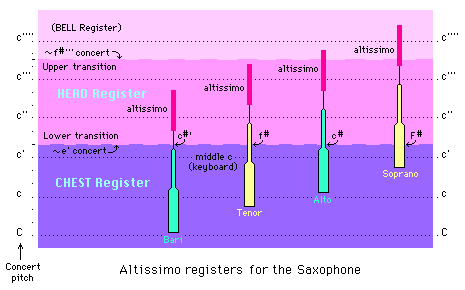
This reveals three important points :
- The Altissimo registers for all saxophones are well above the (Oral tract - ) Chest Register range.
This means that you should first fully develop your Head Register before attempting to play Altissimo notes.
Doing otherwise is an absolute waste of time and only leads to deterioration of the embouchure. - The Altissimo registers for the Baritone and Tenor sax fall comfortably within the Head Register range, and are therefore relatively easy to develop.
- The Altissimo registers for all saxophones are well above the (Oral tract - ) Chest Register range.
- The Altissimo register for the Alto reaches partly and for the Soprano sax almost entirely up into the Bell Register. The altissimo notes that fall within this high range are more difficult to produce, especially on the Soprano sax.
As stated in Lesson 6, the transition to the Bell Register can be shifted upwards by selecting a mouthpiece with very large facing (9* or 10*) combined with a Soft or Medium Soft reed. I recommend this to all Soprano sax players who intend to develop this range. Well controlled notes up to about altissimo C (Bb''' concert pitch) can be produced with this setup.
| Even if you never intend to play in the Altissimo register range, I recommend that you do some practice on it. Having the skills to play in this high range improves your playing of the notes below it considerably. It is similar to the preparation for an exam. If you study more material than you have to, you are that much more confident about your performance. Regard Altissimo practice as an extension to Overtone- or Tone- practice (and include it in the time slot you set aside for these). But above all, most importantly, do not commence Altissimo practice until you are fully skilled in the Head Register range. | 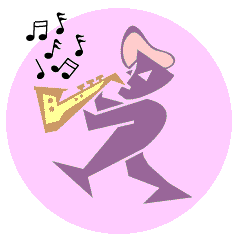 |
SAX 10.6 - Altissimo Fingerings & Exercises
It is relatively easy to overblow the high notes on the saxophone by an interval of a 6th.
- On the alto sax this interval is a major 6th (9 semitones higher).
- On the baritone sax the interval is a minor 6th (8 semitones higher).
- On the tenor sax the interval is in between these two.
The high C ( use mC fingering) on the alto for example will produce an altissimo A; the C# an altissimo A# (Bb). The high D is overblown to an altissimo B, and so on.
This small pitch difference between alto and baritone sax applies to all altissimo fingering.
The Altissimo Finger Chart 1, Chart 2 and Chart 3 reflect this principle.
The Charts contain four fingering choices for each note.
The two on the left are generally flatter in pitch and therefore likely choices for alto and soprano.
The two fingerings on the right are slightly sharper and therefore more suitable for the baritone or tenor.
There are also considerable differences in pitch from one saxophone brand to the next. Experiment therefore with all fingerings provided and determine which fingerings are best for each note on your saxophone.
You can also included the overblown high note fingerings shown above.
Additional altissimo fingerings are published by Teal, Rousseau, Nash and Leonard.
- Practise several major scales over the altissimo range : A, Bb, B, C, D, E.
- Practise several major scales over the altissimo range : A, Bb, B, C, D, E.
- Practise the Altissimo Exercises provided.
- Practise Lost in Space (Alt.) both with Overtone fingerings (as shown) and with altissimo fingerings.
- Sigurd Rasher and Ted Nash also provide good exercises for the altissimo register.
SAX 10.7 - Recommended Practice Schedules
Below three example Practice Schedules you can use.
| It is better to do short practices regularly than long practices followed by several days of not playing. If you can only manage a session less than 1 hour focus on Overtone- and Tone- practice. Try to do these each day, and rotate the other items on the list as time permits. |
Total Practice | 60 minutes | 90 minutes | 120 minutes |
|---|---|---|---|
| Overtones | 20 | 30 | 35 |
| Tone Exercises (& Altissimo) | 10 | 10 | 10 |
| Articulation (& Vibrato) | 5 | 10 | 15 |
| Scales (& Arpeggios) | 15 | 20 | 25 |
| Etudes (& Other) | 10 | 20 | 35 |
- Overtone Practice
- I recommend you put a major effort into Overtone practice (and more time than shown on the Table above) until you are well and truly into the Head Register. After that above Schedules apply.
Use the Overtone Exercises 1 to 8 provided in this Course, and also the Overtone Exercises by Sigurd Rascher. (I have written my exercises to complement those of Rascher's so that they provide a full range from easy to difficult.)
- Tone Practice
- Use the Overtone Exercises 1 to 5 provided. At a later stage you can also include the Altissimo Exercises in this time slot.
- Articulation
- Use the Articulation Exercises provided, including the various articulation patterns for scales.
After playing for about three years : start Vibrato practice in this time slot.
- Scales (and Arpeggios)
- Practise scales in all 12 keys.
First over two octave loops, later over the full range of the instrument.
Play everything meticulously, without stumbles or hesitations, in time and at slow tempo.The essential scales to practice are the :
When you are comfortable playing linear scales start working on the following six scale patterns in all 12 keys, up and down over a two octave range.
- Audio 10.1 (Patterns 1 & 2) : Alto - Tenor
Audio 10.2 (Patterns 3 & 4) : Alto - Tenor
Audio 10.3 (Patterns 5 & 6) : Alto - Tenor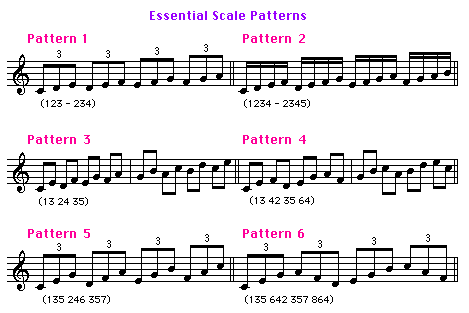
- Practise above patterns from memory and apply the correct Fingering Rules.
For other scales and more information about scales and chords see my Scales Book and Chords Basics - Book 1.Arpeggios
Practise arpeggios of Triads and Seventh chords in all keys as shown in the Chord Practice Routines. Notation for arpeggios in all keys is included in the Lesson Material at the end of this lesson.You can also use some of the many written scale exercises, for example those by Joseph Viola. However the emphasis should be on playing scales and arpeggios from memory.
- Etudes ('Studies')
- Practise scales and scale patterns to perfection.
Etudes on the other hand should not be approached in that manner. Work on an Etude for a short while, especially when you are struggling with it. Then move on to the next one. This way you will stretch you skills continuously.
What is difficult today will be easy for you in a year's time (without the practice), so do not waste valuable practice time on it.A list of suitable material is included on the Reference Page.
This Course also includes twelve Etudes, two in each of the major scales of C, G, F, D, Bb and A. Practise these slowly at first, making sure timing and articulation of the notes are correct.
(See the Practice Studio for Audio Demos)Etudes 1 & 2 in C major Etudes 3 & 4 in G major Etudes 5 & 6 in F major Etudes 7 & 8 in D major Etudes 9 & 10 in Bb major Etudes 11 & 12 in A major
Arrange all exercises of this course in the order shown on the Practice Folder - Contents page. Work each practice session on selected items from the folder going gradually from the beginning to the end. This will help you to have productive and well organised practices.
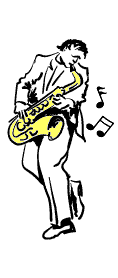 Here some final comments on your practice. Here some final comments on your practice.
|
SAX 10.8 - Doubling of instruments
The Organic Imageries discussed in Lesson 9 are exactly the same for all saxophones regardless of their pitch range. The images are subjective and all in the mind.
The physical shape of the Oral tract (as discussed in Lesson 6) however varies with the absolute pitch of each tone.
The oral tract shape for a D on the alto sax (which is an F concert pitch) is considerably different to that for a D on the tenor sax (which is a C concert pitch)
This means that the connections you make between mind (pitch imagery) and body (oral tract shape) are unique for each instrument.
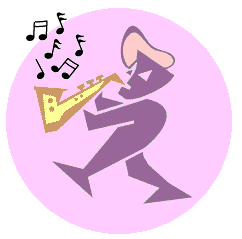 Sax players usually "double" on instruments in the same key. They either combine :
Sax players usually "double" on instruments in the same key. They either combine :
You can approach this aspect in two ways.
 | I hope you have enjoyed this Course. I include some comments on the way I teach saxophone in case you plan to do this yourself. Feel free to ask me any question at any time. Meanwhile, keep that practice rolling along and you will succeed, about that I have No Worries at all ! Michael. |
Acknowledgements Over the years (in the 1980s) I have had excellent tuition from several experienced excellent teachers. Their knowledge has guided me in my own development and understanding of a good saxophone technique. In this regard I especially wish to acknowledge Hal Hall and Bill McKinnon from Adelaide University, and the late Dr. Peter Clinch formerly from Melbourne University. | |
SAX 10.9 - Practice Material
File Name | Contents |
|---|---|
Altissimo Finger Chart 1 | |
Altissimo Finger Chart 2 | |
Altissimo Finger Chart 3 | |
Altissimo Exercises | |
Harmonic minor scales 1 & 2 | |
Major pentatonic scales 1 & 2 | |
Six Scale Patterns | |
Triad chords 1 & 2 | |
Seventh chords 1 & 2 | |
Practice Routines for Chords | |
Sheet music and Demos | |
Practice Folder - Contents page | |
Lost in Space (Altissimo version) | |
Lost in Space : P-a-L for Alto, Baritone | |
Lost in Space : P-a-L for Tenor, Soprano | |
No Worries at all - Lead sheet | |
No Worries : P-a-L for Alto, Baritone | |
No Worries : P-a-L for Tenor, Soprano | |
Test your Knowledge |

